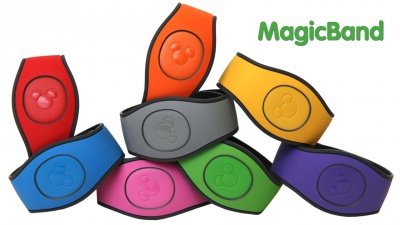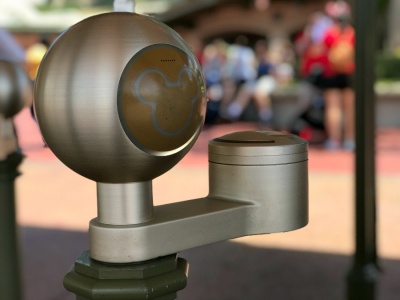Magic Bands
MagicBands are wearable devices that are used in the Walt Disney World resorts & parks in Orlando, Florida. These devices are used to streamline the experience of going to Disney World by collecting data on guest behavior, simplifying transactions, and creating individualized experiences for users. They were first implemented inside Disney parks in 2013 [1], and began being phased out in 2020 to shift their functionality to personal smartphones. [2] MagicBands function using RFID technology, powered by short and long range scanners throughout Disney property. [2] They are packaged in the form of a plastic bracelet in a wide array of colors and patterns with adjustable sizing for adults and children. Some park-goers are concerned about their privacy as a result of the data collection occurring at Disney World using MagicBands.
Contents
History
Before the invention of MagicBands, guests entered the park with paper tickets and turnstiles, used in-park kiosks daily to retrieve paper fastpasses, wandered the park with paper maps, and had little information regarding the popularity of rides and estimated wait times without trekking cross-park to find out.[3] [4]
In 2013, the MyMagic+ suite of technology was phased into use in the Walt Disney World resorts & parks in Orlando, Florida with MagicBands at the forefront of this advancement. [5] With MagicBands, guests can unlock their resort hotel rooms, make Fastpass+ reservations in and outside of the parks, and buy food and merchandise [6]. The Magic Band syncs with users’ My Disney Experience App, displaying personalized experiences, ride photos available for purchase, reservations for fastpasses and dining.
This system was used in Orlando from summer 2013 until early 2020, when the COVID-19 pandemic caused Disney World to close for multiple months. When Disney World re-opened in July of 2020, many changes began to take place including mandatory mask-wearing, social distancing, limited capacity, pausing of the Fastpass+ service, and, later, the phasing out of MagicBands provided free of charge. [7] Beginning in 2021, MagicBands are no longer complimentary when a guest makes a reservation to stay at Disney World in Orlando. This is in preparation for a new update to the My Disney Experience app, which will shift all of the functionality of MagicBands to a user’s personal smartphone. [8]
The Technology of MagicBands
MagicBands are waterproof [9] bracelets, which contain active radio frequency technology (RFID) and a small radio that sends and receives information through park servers. Short range touchpoints are used to verify admission and attraction reservations, and long range readers are used to provide information to parks to gather insights on guest behavior and deliver personalized experiences. [10] RFID technology does not contain any personal identifying information. Rather, each RFID tag contains a unique number that is transmitted to a database, which then can transmit a user’s personal information in response. It has been used in car keys, medical bills, employee identification cards, and toll road tags. [11]
Ethical Concerns
Short-Range RFID: Park Entrance, Fastpass+, Purchases, and Hotels
Technology is used for extreme efficiency in the parks and resorts. When users touch the Mickey Mouse icon on their Magic Band to a matching Mickey Mouse icon on a short range touchpoint, they elicit a colorful reaction from the touchpoint to confirm the interaction - green for go, or blue for pause. [1] Similar to park entrance, guests touch their MagicBands to short-range touchpoints with Mickey Mouse icons to validate their Fastpass+ reservations. These reservations can be made before or after entering a park using the My Disney Experience app on a smartphone, and that data is shared with the RFID technology to use a Magic Band to validate a reservation. Guests can also use in-park kiosks to make Fastpass+ reservations. [12] For merchandise and casual dining purchases,MagicBands utilize short-range radio frequency readers, which access the credit card information optionally inputted by a guest to streamline the payment process [13] MagicBands are also used to unlock guests’ hotel doors if they stay at a resort on-property. [8] These features are not used by all guests because of the security risks associated with having personal information so readily available. [14]
Location Tracking: Personalized Dining & Lost Guests
MagicBands can use long range readers to track the locations of guests. This technology is utilized in Disney’s Be Our Guest restaurant to notify waitstaff of a guest’s arrival as well as their name and dinner order. Guests are greeted by name and then recieve their dinner orders after being seated without ever having to tell a waiter or waitress what they want. [1] Disney also claims that MagicBands can be used to track and locate guests who have lost their parties. [9]
Data Collection: My Disney Experience
The incorporation of all of these features in one wearable piece of technology results in a detailed collection of information about every guest, including their spending habits, eating habits, movement around the park, and interest in characters. [3] Disney claims to use this information to provide personalized experiences for their guests, including being greeted by name and sharing personal details like birthdays and anniversaries with employees for personal interactions. [15] Disney also uses this data to manage traffic flow around the park, as they can direct crowds and decrease congestion by sending characters to less popular areas. [9] Guests who opt into Disney’s Magical Express program use MagicBands before entering Disney property, as Disney-owned buses will pick up incoming guests from the Orlando Airport and automatically check them into their resorts using MagicBands. [9] While these features can be useful and enjoyable, some guests also express discomfort with the level of surveillance they and their children are under when they choose to use MagicBands. [3]
Less Invasive Options
Disney provides a less technologically advanced option for guests who are not interested in using MagicBands. Guests can instead receive a plastic card, much like an identification or credit card, that only uses passive RFID, which can only be used at a short range. This card will prevent Disney from collecting location data and sharing personal information with employees.
Furthermore, guests are not required to allow personalization functions during their stays. Guests can choose to withhold their names from employees and opt out of receiving special offers. [15] Disney CEO Bob Iger states that MyMagic+ is a completely optional program that was designed with privacy controls from the outset." [3]
References
- ↑ 1.0 1.1 1.2 Kuang, Cliff. “Disney's $1 Billion Bet on a Magical Wristband.” Wired, Conde Nast. [1]
- ↑ 2.0 2.1 Magic Band Eligibility | FAQ [2]
- ↑ 3.0 3.1 3.2 3.3 Perez, Chris. “Disney Uses Apps, 'MagicBands' to Track Guests: Report.” New York Post, New York Post, 24 July 2019. [3]
- ↑ Pugh, Jena. “FROM PAPER TO PAPERLESS: EVOLUTION OF DISNEY FASTPASSES.” Best of Orlando, 13 Feb. 2015. [4]
- ↑ Carr, Austin. “The Messy Business Of Reinventing Happiness.” Fast Company, Fast Company, 2 Dec. 2017. [5]
- ↑ What is a MagicBand? | FAQ [6]
- ↑ Pallotta, Frank. “Disney Parks Chief on Reopening: 'We Are in a New Normal'.” CNN, Cable News Network, 11 July 2020. [7]
- ↑ 8.0 8.1 MagicBands & Admission Cards [8]
- ↑ 9.0 9.1 9.2 9.3 Shamblin, Quinn R. “Disney Balances Convenience and Privacy.” CSO Online, CSO, 12 Jan. 2015. [9]
- ↑ Radio Frequency Technology | FAQ [10]
- ↑ Radio Frequency Identification (RFID): What is it? [11]
- ↑ What is Fastpass+ and How to Use It [12]
- ↑ My Disney Experience & MagicBands | FAQ [13]
- ↑ “Privacy Concerns Over Disney MagicBand.” Security Magazine RSS, Security Magazine, 1 Jan. 2014. [14]
- ↑ 15.0 15.1 Barnes, Brooks. “At Disney Parks, a Bracelet Meant to Build Loyalty (and Sales).” The New York Times, The New York Times, 7 Jan. 2013. [15]

